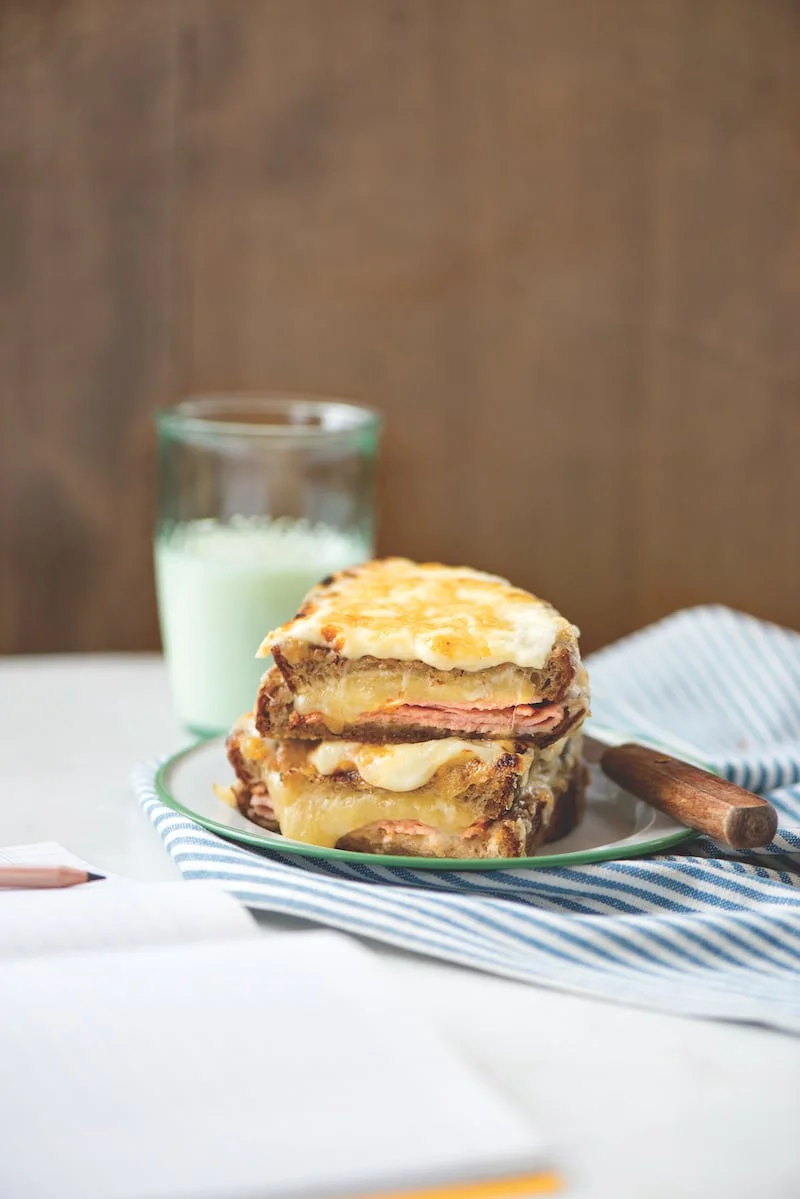In her new book In the French Kitchen with Kids: Easy, Everyday Dishes for the Whole Family to Make and Enjoy, Mardi Michels forgets the fuss and brings simple, elegant French dishes to life with a few tips to get the kids involved too. Cooking French foods with kids is a great way teach them about another culture while honing their kitchen skills.

From pastries to breakfast, lunch, dinner and even a hefty dose of vegetable dishes, this is a great cookbook to get kids involved and excited about making their food. Not sure if you’re kids will like French food? It’s not all frog legs! Start with something approachable, like a cheesy pasta bake, croissants or roast chicken. Then move on to more veggie-loaded dishes like ratatouille or fish cakes. We asked Mardi what a good way to introduce or entice a young eater to fish.

“Speaking as a former young tentative fish-eater myself, I can tell you that breadcrumbs are your friend! And cheese. And possibly some frying action! When I was younger I would only ever eat fish fingers (shocking, considering I grew up in Australia!) and from my work cooking with kids, I know that sometimes fish isn’t their favourite. There are two fish recipes in In the French Kitchen with Kids that I developed because I knew they would have appealed to me as a child – a plain fish fillet coated in lemon-y, cheesy breadcrumbs, and some fish and potato cakes which are coated in crunchy breadcrumbs and then pan-fried – and both are proving to be a hit with kids and parents alike!”
How do you encourage a child to get hands-on with a food project when they don’t like to have messy hands?
“I find that how fussy kids are about getting messy depends on the food. For example, if they are working with cookie dough (or pastry), they don’t tend to mind so much. It’s the things like meat and fish where they get squeamish. That said, it IS important that kids get hands on in the kitchen as so much of cooking is about using all your senses, including touch. I always have gloves on hand for those kids who are squeamish around things like raw meat because I don’t want them to miss out on the experience.”
Do you have a current favorite ingredient that you can’t get enough of right now?
“My favourite seasonal ingredient right now is tomatoes – I spent some time in France this summer and couldn’t stop buying, eating and cooking with all manner of varieties of them. One of my favourite French recipes to use up all those tomatoes is a Tomato and Mustard Tart (rustic so, perfect for kids to make too!)”

So get into the kitchen with the kiddos! And be sure to check out Mardi’s cookbook for more doable recipes and tips. Try the recipe below for quick croissants from the book.
Print
Quick Croissants
- Yield: 10 croissants 1x
Description
Typically, croissants are made using a laminated dough, where layers of butter are rolled and folded into the layers of dough. This is a complex technique that takes the better part of a day to do properly and doesn’t really belong in a book of “easy, everyday” recipes for children, but I couldn’t write a French cookbook and not include a recipe for croissants. This one borrows a technique from the great Julia Child, who borrowed it from Beatrice Ojakangas (author of The Great Scandinavian Baking Book) for inclusion in Baking with Julia. It produces a fluffy, rather than super- flaky, croissant. This is definitely one of the more advanced recipes in the book, not because it’s difficult, but because it requires a bit of planning and some precision in the rolling and folding. But if you set out to make this a weekend project and take each step slowly, you’ll be thrilled with the results. These do require a bit of planning but they are so worth the effort! A suggested timetable is as follows: Day 1: 60 minutes’ hands-on time, in stages, 60-minute rest in fridge. Refrigerate overnight. Day 2: 45 minutes’ hands-on time (rolling, measuring), 3 hours’ proofing time, 20 to 25 minutes’ bake time. Have you ever wondered why even though the word “croissant” means “crescent,” many croissants are straight, not crescent-shaped? In France, shaping a croissant straight as opposed to rounded is a way of showing that it is made with pure butter (as opposed to margarine or another fat). You’ll often see them sold as croissants au beurre (butter croissants) and croissants ordinaires (ordinary, i.e., NOT butter, croissants). Looking for the croissant’s chocolaty cousin the pain au chocolat? You’ll find it on page 63 in the After-School Snacks chapter, as it’s traditionally enjoyed in the afternoon.
Ingredients
- 1/2 cup 125 mL 2% milk
- 21/2 teaspoons active dry yeast
- 1 1/2 cups 225 g all-purpose flour
- 1/4 cup 50 g granulated sugar
- 1 cup 226 g cold salted butter or European-style butter, cut into rough cubes
- All-purpose flour (for rolling and shaping)
- 1 egg (lightly beaten)
- 1 tablespoon heavy (35% cream)
Instructions
- Heat the milk to between 110?F and 113?F (approx. 45?C) in a medium pot over medium heat (use a digital thermometer to measure the temperature). If heating in a microwave, use a microwave-safe bowl and start with 30 seconds on high. Continue to heat in increments of 15 seconds and be sure not to overheat.
- Pour the milk into a large heatproof bowl and sprinkle the yeast over it.
- Let it sit for 10 minutes. It will be slightly frothy on top after this time.
- Meanwhile, place the flour, sugar and then the butter in the bowl of a food processor fitted with a metal blade. Pulse eight to ten times— you should still be able to see large chunks of butter.
- Tip the flour/butter mix over the warmed milk and use a wooden spoon to just incorporate the dry ingredients into the milk. The dough will be lumpy, shaggy and quite dry at this point.
- Use your hands to form a ball of dough. It might need a bit of work, but keep going—it will come together! Cover the bowl tightly with plastic wrap and place it in the fridge for at least 1 hour (don’t leave it much longer than this, though, because it will become too difficult to roll out).
- Remove the dough from the fridge and lightly flour your countertop.
- Knead the chilled dough gently until you can feel it becoming softer. Use your hands to shape it into a rough rectangle.
- Lightly flour a rolling pin and roll out the dough until you have a very large rectangle (8 x 17 inches/20 x 40 cm). You should be able to see butter pieces in the dough. If the edges of the rectangle crack a little as you are rolling, simply push them together with your fingers and continue to roll until you have the correct size of rectangle.
- Fold the top of the dough about two-thirds of the way down, then fold the bottom third up over the first fold. You might need a plastic bench scraper or spatula to help you scoop up the dough if it’s sticking a little.
- Turn the block of dough clockwise so the seam (the open side) is on your right. This rolling and folding is known as a “turn.”
- If the dough or work surface is sticky, lightly flour the surface, brushing off any excess flour with your fingertips or a pastry brush, and lightly flour the rolling pin again. Repeat Steps 7 through 9 seven times for a total of eight “turns.” Make sure you brush the excess flour off the pastry and the rolling pin each time, though you shouldn’t need very much extra flour. This dough is very smooth and elastic and rolls beautifully.
- Wrap the dough tightly in plastic wrap and refrigerate for a minimum of 3 hours, but preferably overnight.
- Line two baking trays with parchment paper. Remove the dough from the fridge and place a large piece of parchment paper on your countertop or table. Let the chilled dough sit for a few minutes so it’s not completely cold when you start working with it. Roll the dough until you have a rectangle that is a little over 8 x 24 inches (20 x 60 cm). This may take a bit of patience, but if you take it slowly, the dough will definitely roll out this large. Trim the edges of the rectangle so they are neat and straight—a tape measure and pizza cutter work well for this.
- Working along the long sides of the rectangle, make a small cut in the dough on each side of the rectangle every 41/2 inches (12 cm). Place a tape measure across the width of the dough at the first mark. Use a long sharp knife or a pizza cutter to cut a rectangle across the width of the dough. Repeat at each mark until you have five rectangles.
- Cut each rectangle in two diagonally to make two triangles. Use a tape measure (to make sure the triangles are even) and a pizza cutter to do this. You’ll have 10 triangles.
- Gently stretch one of the triangles at each corner, then, working from the wide end, roll up the dough until you have reached the pointed end. Voilà, you have a croissant. Repeat with the remaining triangles. You might find that some of your croissants are not quite the shape you think they should be—again, practice makes perfect and they will still taste amazing!
- Place five croissants on each tray and cover each tray with a clean tea towel. Leave to rest in a warm place for 3 hours. The croissants will puff up slightly during this time.
- When the croissants have been resting for 21/2 hours, preheat the oven to 375?F (190?C). Whisk the egg and cream together and gently brush the tops of the croissants with this egg wash.
- Place one tray in the top third of your oven and the other in the bottom third of the oven. Bake for 20 to 25 minutes, or until the croissants are golden brown on top. Switch the trays from top to bottom and turn them from front to back halfway through baking.
- Remove the baking trays from the oven. Let the croissants sit on the baking trays for about 10 minutes, then place them on a wire rack to cool completely (if you can wait). They will keep for 2 to 3 days in a resealable plastic bag (you can pop them in the microwave to reheat for a few seconds).
























Is it really hard to make